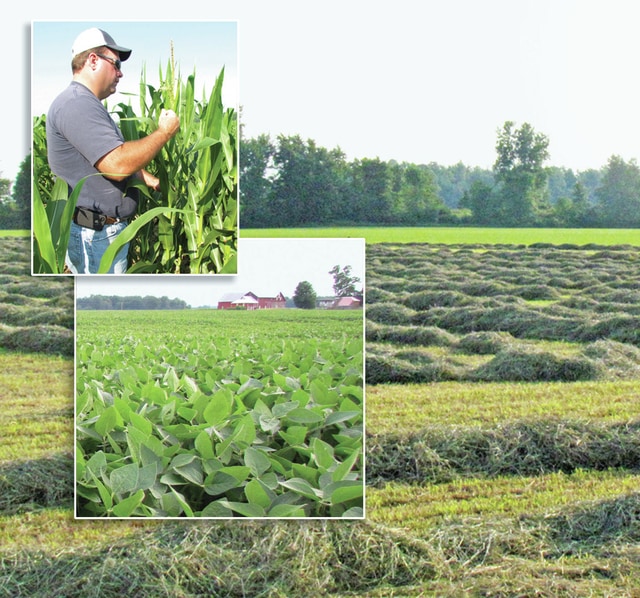The planting season for 2015 got off to a wet start in north central Ohio, and the effects will be evident at fall harvest.
A rainy Spring that just kept going and going prevented growers from getting into fields to take off winter wheat and the first hay cutting.
“There were about three days that were fit to harvest (winter) wheat,” said Morrow County farmer Anthony Bush, who also serves as the NCGA finance committee chair and is a board member of the Ohio Corn & Wheat Growers Association. “After that, it went downhill.”
Jeff McCutcheon, OSU Extension Agent for Morrow County, agreed.
“A lot of the rains hit right around harvest, so it delayed it, which left the wheat exposed to moisture longer,” he said. “A lot of the wheat harvested was not food quality, so it reduced its value. It can be used for livestock feed after it is tested for toxins but, overall, there will be more loss this year than normal because the biggest portion of it wasn’t milling quality.”
“If you didn’t harvest July 4, 5 or 6, the quality really went down,” Bush noted, adding the wheat would have sprouted after that. “Wheat is a very temperamental crop: you’re trying to raise a food grade crop and we just had so much trouble this year trying to get the wheat off. It endured so much rain throughout the month of June, when it finally matured, the ground conditions were barely fit.”
What could not go to the mill was used for animal feed. Bush said a lot of it went to the Carolinas for turkey feed, but because farmers only got half price for the grain, it was a ‘huge loss.’
As for hay, a multiharvest crop, McCutcheon said the biggest determiner of its quality is the plant’s maturity when it’s cut.
“Once the plant has matured, the quality starts to drop after that,” McCutcheon said. “For the vast majority, cutting was delayed, so the quality is down. Getting it baled at the right moisture is important.”
Though the second cutting was better quality, he noted 60% of a yearly yield comes from the first cutting.
“The regrowth is never the same volume as Spring growth,” he said, adding there is still some nutritional value in lesser quality hay, but supplemental feed is needed. “You want to feed animals at levels they are productive, so you’d have to add what the hay is not providing. There is an added cost then.”
Both men agree corn is highly variable this year. Much depended on when it got in, because rains limited application of herbicides and fertilizers and nitrogen.
Bush said there was a window of time in early May to get corn and soybeans in the ground under nice conditions.
“Things had just about a perfect start to it, then it started raining and didn’t quit for six weeks,” he said. “At my place, we had 17 inches of rain in about 6 weeks. It was a problem.”
Because of this, McCutcheon said some corn is exhibiting ‘nitrogen stress.’ Root growth can be impaired by sitting in water because they also need air.
“Fields are never uniform in their soil,” he said, “so there may be spots where the corn won’t mature at all.”
Again, the precipitation delayed application of fertilizers and crop spraying, and areas of fields that held pools of water for extended periods were damaged. But other areas ‘came around.’
“I think we’re going to have a good crop, but it won’t be a blockbuster by any means,” said Bush, who farms 1,400 acres of corn, soybeans and wheat. “It won’t be a total loss all over. There will be ups and downs across the fields. You’ll be able to tell where every tile string is!”
He said Ohio AgNet Country Journal did a two day crop tour across Ohio and they are still ‘pegging’ the average corn yield for Ohio at 166 bushels, which Bush said is not a bad average across the state.
Now it’s been dry, and McCutcheon said we are starting to see stress on plants – the corn’s shallow roots aren’t getting the water they need. “It would be ideal if we could get an inch of rain each week.” Overall, he feels corn yields will be down.
“Corn that cannot be used for feed can be used as ruminant livestock feeds for cows or sheep, so there is some salvage value there,” he said.
Bush said ‘timely rains’ in the last few weeks have helped the soybeans.
“They have a longer window to produce a crop, so they’re looking pretty good now,” he stated. “For awhile, it was questionable – there were whole sections of fields that were drowned out. Beans need rain in August, and we’ve been getting that; I still have hopes for a decent soybean crop. I think you’ll see beans starting to come off around the 15th or 20th of September. That’s normal.”
Reach Randa Wagner at 419-946-3010, ext. 1803 or on Twitter@MorrCoSentinel.






